【英语教学设计】Module8 Unit2 It’s hot and sunny today.
四年级下册英语教学设计-Module8 Unit 2 It's in the north of Ch

四年级下册英语教学设计-Module 8 Unit 2 It’s in the northof China一、教学目标1.能熟练运用以下短语:in the north of China, in the south of China, in the west of China, in the east of China, in the middle of China, in the northeast of China, in the northwest of China, in the southeast of China, in the southwest of China。
2.能掌握以下句型:Where is Beijing? Beijing is in the north of China. Where is Guangzhou? Guangzhou is in the south of China。
3.能说出中国主要地区的基本位置。
4.能够流利交流地点所在区域。
二、教学重难点重点1.短语的掌握;2.句型的熟悉。
难点如何让学生准确表达地点所在的方位,如东南、西北等。
三、教学内容、过程与方法(一)教学内容1.1a课文内容的复习(四个城市的介绍)。
2.1b对于城市的地理位置的学习,学习地点所在省份和方位。
(二)教学过程1、复习1a的课文内容1.教师呈现四个城市的图片,询问学生对于这些城市有何了解。
2.教师指出这些城市的名字及他们所在的位置,要求学生边听边看相应的图片,尽量记住这些城市及其位置。
3.教师带领学生回顾刚才学过的内容,询问四座城市的基本情况。
2、学习地点所在省份及方位1.教师出示一张中国地图,并放大到学生可以清晰地看到各省份的位置,要求学生认真观看。
2.教师向学生介绍各省份大致方位并简要介绍其地理位置。
3.向学生详细介绍如何表示地点所在的位置,举例说明。
例如:北京在中国的哪个位置?“北京在中国的北方。
外研版(一起)二年级英语上册《Module 8 Unit 2》教案设计

外研版(一起)二年级英语上册《Module 8 Unit 2》教案设计教学目标•学生能听懂并理解指令。
•学生能认读并熟练掌握所学的英语单词。
•学生能理解并做出正确的动作表达自己的意思。
•学生能使用所学单词表达自己的喜好和倾向。
教学重点•学生能正确使用所学单词构建简单的句子。
•学生能听懂、理解并做出正确的动作。
教学难点•学生能够使用所学单词和表达方式进行口语交流。
教学过程导入环节1.教师展示所学单词的图片,让学生认读并说出单词。
2.教师通过比划动作的方式,则引导学生理解所学单词的意思。
新课授课1.学习单词:jump, dance, sing, run。
2.教师通过比划动作的方式,启蒙口语,帮助学生理解各单词的意思。
3.学生跟随教师口头指令做出正确的动作。
4.教师引导学生跟随语音模仿,锻炼学生的口语表达能力。
活动安排1.学生分为小组,进行互动协作。
2.学生进行对文本和所学单词的回忆练习。
3.学生利用所学单词和表达方式互相交流,达到提高口語技能的目的。
课后作业1.学生练习所学单词和表达方式,提升和巩固口语表达能力。
2.学生课外进行英语阅读,加强对英语的学习。
总结教学过程中,学生通过参与互动掌握了单词和表达方式,通过对话和动作教学,学生对所学英语表达技巧的掌握有了更深层次的理解与掌握,并且在实际应用中更加自信地运用英语交流沟通,同时教师积极肯定学生表现,激发学生学习英语的兴趣和动力,从而提高学生英语学习效果。
参考资料教材:《外研版》(一起)二年级英语上册。
Module8_Unit2_I_took_some_pictures教学设计

Module8 Unit2 I took some pictures.教学内容分析本模块的教学内容是谈论和评价过去的行为。
本单元的课文情境是Daming向妈妈介绍这次野餐的情形。
他告诉妈妈这次野餐玩得很开心:他们做了游戏,吃了很多好吃的东西,喝了果汁和牛奶,他还拍了很多照片,制作了一张海报。
妈妈表扬了Daming。
教学目标1、全体学生能认读took,tell,great,made并运用;全体学生能理解took,tell,great,delicious,made,poster,部分学生能运用delicious,poster2、全体学生能听懂、会说I took some pictures.3、全体学生能够运用一般过去时谈论和评价过去的行为。
4、全体学生能够积极运用所学英语进行表达和交流,乐于感知并积极尝试使用英语。
教学重难点不规则动词的过去式教学过程Lead in1、Greeting2、Warming up(1)Brain stormingRead the words or the phrases quickly and loudly.(2)Let’s sing a song <What did you do?> and do the actions.(设计意图:快速复习动词过去式及动词过去式短语,复习句型What did you do?及回答。
)3、Lead inI took some pictures last weekend.What did you do last weekend?Look at Daming ,can you guess what did Daming do?Today we’ll learn Module8 Unit2 I took some pictures.4、Watch a video<Peppa pig’s picnic>5、GroupDo you want to have a picnic? Today we have two groups. We’ll get lots of delicious food for our picnic. Let’s PK. Ready?(设计意图:观看小猪佩奇的视频,引入Picnic主题,带入情境并分组加入竞争机制)Presentation1、Last Sunday,Daming had a picnic too.Let’s have a look.(1)Watch and answer.What did Daming do on picnic?( D )A.He played games.B.He ate lots of delicious food.C.He took some pictures.D.A BC(2)NewBoys and girls ask Daming,listen to the voice.Read the sentence after the voice .Then study the new words.(3)Listen and repeat,then circle the past tense of verb.(4)Role playIt’s role play time,I’ll give you one minute.Work in pair,clear?(5)Fill in the blanks.Mum:Tell me about your picnic.Daming: It was .We games.We lots of delicious food.I some pictures and I a poster.Mum:That’s great!(6)The simple past tense(微课)(设计意图:学习单词和课文,词不离句,再通过多种角色扮演、填空、复述课文等多种练习,更好的掌握课文。
Module8Unit2It’shotandsunnytoday教案

Module 8 Unit2 It’s hot and sunny today.(一)知识目标:1、能会说、认读单词:sunny/ windy/ rain/ snow, spring/ warm summer/hot Autumn /cool winter/cold;2、能用It is … today.描述天气;It is … in spring.描述季节天气特征;We …in spring.介绍简单的季节活动。
3、表演唱歌曲:Rain, rain, go away.(二)能力目标:1、能用恰当的形容词介绍天气;2、能运用句型描述季节天气特征和季节活动。
(三)情感目标:通过谈论季节与天气这一话题,让学生感受自然四季之美,激发学生热爱大自然,热爱生活的美好情感。
二、教学重点:1、单词的发音和认读:sunny/ windy/ rain/ snow2、句型:It is windy/sunny/raining/snowing today.三、教学难点:使用What do you do in summer(winter, etc)?进行询问。
四、教具:季节和天气的图片五、教学过程:Step1 Warming up1. 四季欣赏:复习sunny/windy/rain/snow,为下面的环节的进行做好知识与情感的铺垫;欣赏四季美景,激发对大自然的向往和热爱之情。
2. Guessing Game:检测巩固学生对sunny/windy/rain/snow的发音与反映情况。
Step2 Presentation1. Color Game :( Unit2Part5)活动设计:Colorful Seasons:五彩缤纷的季节。
(四季五彩缤纷的色彩,引导学生描述颜色,让其他同学猜一猜所描述的季节。
)2. 重难点导入与导学(Unit2 Part1)以旧知引新知。
由Unit1的季节天气复习与检测设置进入本课单词“sunny/windy/ rain/snow”,句型“It is ...and ...today.”的情景,引导学生学习和认知新单词和句型。
新外研版英语三下Module8 Unit 2(全模块)教案
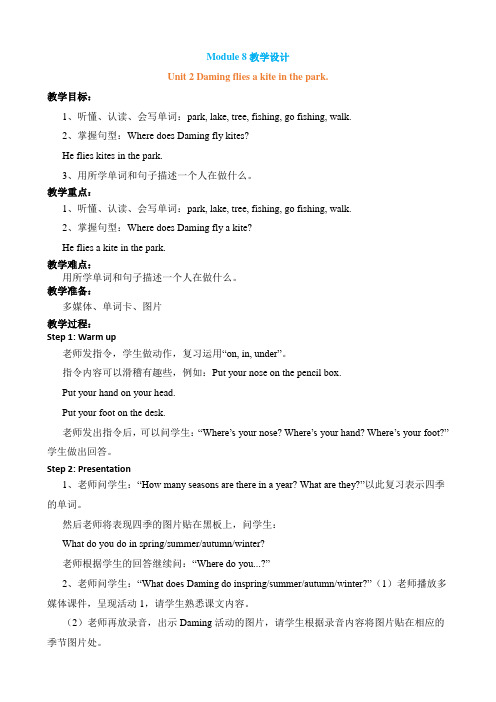
Module 8教学设计Unit 2 Daming flies a kite in the park.教学目标:1、听懂、认读、会写单词:park, lake, tree, fishing, go fishing, walk.2、掌握句型:Where does Daming fly kites?He flies kites in the park.3、用所学单词和句子描述一个人在做什么。
教学重点:1、听懂、认读、会写单词:park, lake, tree, fishing, go fishing, walk.2、掌握句型:Where does Daming fly a kite?He flies a kite in the park.教学难点:用所学单词和句子描述一个人在做什么。
教学准备:多媒体、单词卡、图片教学过程:Step 1: Warm up老师发指令,学生做动作,复习运用“on, in, under”。
指令内容可以滑稽有趣些,例如:Put your nose on the pencil box.Put your hand on your head.Put your foot on the desk.老师发出指令后,可以问学生:“Where’s your nose? Where’s your hand? Where’s your foot?”学生做出回答。
Step 2: Presentation1、老师问学生:“How many seasons are there in a year? What are they?”以此复习表示四季的单词。
然后老师将表现四季的图片贴在黑板上,问学生:What do you do in spring/summer/autumn/winter?老师根据学生的回答继续问:“Where do you...?”2、老师问学生:“What does Daming do inspring/summer/autumn/winter?”(1)老师播放多媒体课件,呈现活动1,请学生熟悉课文内容。
外研版小学英语(一年级起点)五年级上册Module8 Unit2 参考教案

Module8 Unit2 参考教案一、教学内容外语教学与研究出版社(一起点)五年级上册第一模块Unit2 There are lots of games.二、教学过程建议(一)热身导入1. 师生互致问候,请学生唱Module7 Unit2活动4的歌曲,说Module8 Unit1活动1的韵句。
2. 展示SB Unit2活动1的挂图,请学生看图,描述图片内容。
教师可以问学生: “周末大家都干什么呢?Sam打算今天做什么?”3. 播放动画或录音,请学生看动画或边听录音边看挂图,通过回答问题理解语境:同伴约Sam出去玩,Sam拒绝了,因为他要认真学习。
4. 再次播放录音,请学生跟读,可以先全班跟读,再小组跟读、个人跟读,跟读中注意韵句的韵律和节奏。
同时教师简单讲解单词“study,op en”的语义。
此处要求学生仅理解并跟读单词即可,不要求能够运用,可以到活动2时再进行运用训练。
5. 请学生两人一组,一边拍手一边说韵句。
最后请部分学生展示。
(二)任务呈现1. 教师告诉学生:“今天我们要写短文,制作海报,向英国小朋友介绍我们的学校。
”(三)课文学习1. 播放SB Unit2活动2的录音,请学生看动画或听录音边看挂图,教师帮助学生理解语境。
2. 再次播放录音,请学生完整地听一遍课文录音。
播放第三遍录音,请学生逐句跟读。
3. 在跟读过程中学习“wall, have fun, break”的语义,并对单词“study”进行运用训练。
4. 若学生学习词汇有一定困难,教师可引导学生构建本模块的词汇图,或扩展到已学相关词汇构建话题词汇图,帮助学生形成词汇的关联意识,巩固所学词汇。
5. 完成AB Unit2练习1。
教师引导学生理解练习要求:听录音,判断语句信息与课文内容是否相符。
若相符,则在“T (True)”下面的空格打钩;若不相符,则在“F (False)”下面的空格打钩。
播放课文录音,请学生听录音,判断语句。
外研版九年级英语下册Module 8 Unit 2 【创新教案】
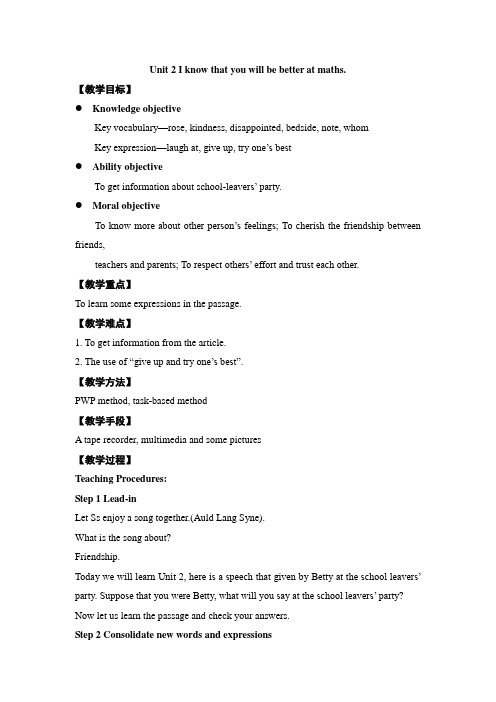
Unit 2 I know that you will be better at maths.【教学目标】●Knowledge objectiveKey vocabulary—rose, kindness, disappointed, bedside, note, whomKey expression—laugh at, give up, try one’s best●Ability objectiveTo get information about school-leavers’ party.●Moral objectiveTo know more about other person’s feelings; To cherish the friendship between friends,teachers and parents; To respect others’ effort and trust each other.【教学重点】To learn some expressions in the passage.【教学难点】1. To get information from the article.2. The use of “give up and try one’s best”.【教学方法】PWP method, task-based method【教学手段】A tape recorder, multimedia and some pictures【教学过程】Teaching Procedures:Step 1 Lead-inLet Ss enjoy a song together.(Auld Lang Syne).What is the song about?Friendship.Today we will learn Unit 2, here is a speech that given by Betty at the school leavers’ party. Suppose that you were Betty, what will you say at the school leavers’ party? Now let us learn the passage and check your answers.Step 2 Consolidate new words and expressionsThe teachers shows the new words and expressions of this lesson.rose n. 玫瑰kindness n. 善举;好意disappointed adj. 失望的bedside n. 床边note n. 便条whom pron. …….的人,那个人,那些人laugh at 嘲笑give up 放弃Step 3 Pre-reading1. Ask Ss to look at the picture and choose the answers to the questions. There may be more than one answer.1) Who will probably get thanks from the school-leavers?a) Familyb) Friendsc) Teachers2) What is the speaker probably going to say?a) Thank you.b) Good luck!c) Cheers!2. Now Give Ss some time to read the passage and check.1) Who will probably get thanks from the school-leavers?a) Family √b) Friends √c) Teachers √2) What is the speaker probably going to say?a) Thank you. √b) Good luck!c) Cheers!Step 4 ListeningPlay the recorder of part 3 for Ss and ask them to answer the questions.1. How many roses does the speaker have?2. Did the speaker’s father buy a violin?Keys: Three.Yes, he did.Step 5 Reading1. Ask Ss to find sentences which show the following situations in the passage:1) the three things the speaker has learnt2) the three groups of people the speaker wants to thank3) what the speaker has learnt from each group of peopleKeys:1) These three things are friendship, effort and trust.2) I give the red rose to my friends.I give the white rose to my teachers.I give the yellow rose to my parents.3) She has learnt kindness from her friends, effort from her teachers. The parents taught her that love is about trust.2. Questions for Ss:1) Which sentence i n Paragraph 4 means “You have to work hard to succeed”?2) “You only re ally los e if you give up!” What does the sentence mean?3) “I’m sure y ou will be good at music. I know that you will be better at maths.”What did Betty’s father want her to do?4) How do you think Betty would write to her father in reply?5) “I’m sure that you all have your own memories about the happiness of the lastthree years, and the people whom you want to thank for it…”What does it mean?Keys:1) “You only really lose if you give up!”2) 只要你坚持下去,跑完全程,那么即使你最后一个到达终点,你也不是一个失败者。
(外研版)英语五年级上册教案MODULE8unit2

NSE (三年级起点)五年级上册教案Module 8 SchoolUnit 2 Where did Lingling go yesterday?教学重点:Where did Lingling go yesterday?Can I ask you some questions?What do you do at break?教学难点:/s/ /z/ 的发音及其对应的字母和字母组合歌曲:I get up in the morning.教学用具:radio and pictures.功能:描述学校日常生活运用任务:1.能够互相询问有关学校的信息;2.调查朋友的学校生活;3.谈谈自己理想中的学校生活。
教学程序:1热身复习教师说出一些句子,请同学判断是中国学校还是英国学校。
学生介绍中国小学和英国小学的不同。
2任务呈现与课文导入教师问:我们已经知道了中英学校之间的不同,下面我们来讲一讲生活的不同。
教师询问学生每天的生活情况,与较好的学生进行下面的问答:Can I ask you some questions?What time do you get up?How do you go to school?What do you do after school?What time do you go to bed?What do you do at the weekend?将上面的问题重复说出,请学生回答,将问题写在黑板上,教师说出,学生重复。
3课文教学⑴学习新词教师画出本校的时间表,讲解break,教师写出8:00—8:40,说This is the first class. 再写出8:40—8:50,说This is the break. 继续写8:50—9:30,说This is the second class.请学生说出它的汉语意思。
教师读单词break,学生重复。
问学生What do you do at break?帮助学生回答I talk with friends at break.I have a rest at break.I drink water at break.教师说:I have a rest at break. 边说边做喝茶的动作,在黑板上画出一杯茶,教读单词tea.⑵SB Unit2 活动1放第一遍录音,学生找出对话中有几个人,名字是什么。
新外研版九年级上册英语 Module 8 Unit 2 教案(教学设计)

Module 8 Sports lifeUnit 2 He was invited to competitions around the world.单词sportsman, high jump, ability, hurdling,能够读懂介绍刘翔的短文,获取主旨大意及相关细节信息一般现在时的被动语态的理解和运用.Step 1情景导入T:Do you know Liu Xiang?S1:Yes,I do.He is a runner.T:What else do you know about him?S2:He won an Olympic gold medal.T:Where does he come from? If we want to know more about him and other players.Let’s search on the Internet.Step 2完成教材Activities 1,2的任务1.Look at the picture and the title of the passage in Activity2. Say what you know about Liu Xiang and how he became a sports hero. (Activity 1)(1)学生谈论图片,教师可以提出以下问题:Who’s the man in the picture?When and where did he get his Olympic gold medal?How did he feel at that moment?(2)学生四五人分成一组,就他们了解或査阅到的信息讨论运动员刘翔,包括刘翔遇到的困难,赢得的奖励和获得的荣誉等,每个组派一个组员就讨论结果进行记录总结。
(3)教师抽点小组,向全班展示讨论结果,汇报信息。
(4)教师汇总所有小组的讨论结果,剔除重复信息,得到一份关于刘翔经历的详细清单。
五年级上册英语教学设计-Module8 Unit 2 There are lots of games
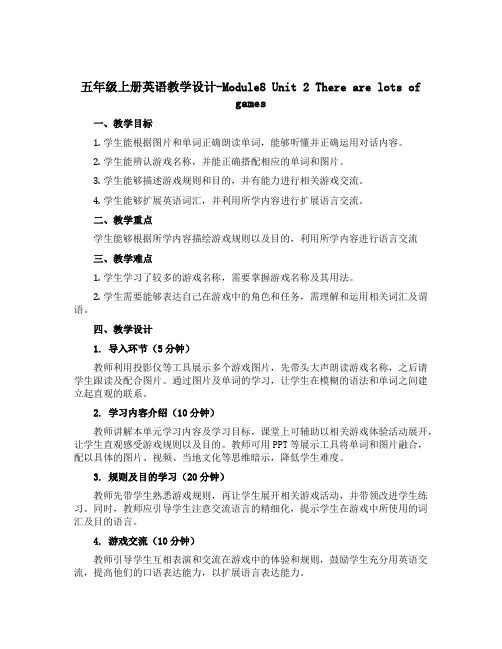
五年级上册英语教学设计-Module8 Unit 2 There are lots ofgames一、教学目标1.学生能根据图片和单词正确朗读单词,能够听懂并正确运用对话内容。
2.学生能辨认游戏名称,并能正确搭配相应的单词和图片。
3.学生能够描述游戏规则和目的,并有能力进行相关游戏交流。
4.学生能够扩展英语词汇,并利用所学内容进行扩展语言交流。
二、教学重点学生能够根据所学内容描绘游戏规则以及目的,利用所学内容进行语言交流三、教学难点1.学生学习了较多的游戏名称,需要掌握游戏名称及其用法。
2.学生需要能够表达自己在游戏中的角色和任务,需理解和运用相关词汇及谓语。
四、教学设计1. 导入环节(5分钟)教师利用投影仪等工具展示多个游戏图片,先带头大声朗读游戏名称,之后请学生跟读及配合图片。
通过图片及单词的学习,让学生在模糊的语法和单词之间建立起直观的联系。
2. 学习内容介绍(10分钟)教师讲解本单元学习内容及学习目标,课堂上可辅助以相关游戏体验活动展开,让学生直观感受游戏规则以及目的。
教师可用PPT等展示工具将单词和图片融合,配以具体的图片、视频、当地文化等思维暗示,降低学生难度。
3. 规则及目的学习(20分钟)教师先带学生熟悉游戏规则,再让学生展开相关游戏活动,并带领改进学生练习。
同时,教师应引导学生注意交流语言的精细化,提示学生在游戏中所使用的词汇及目的语言。
4. 游戏交流(10分钟)教师引导学生互相表演和交流在游戏中的体验和规则,鼓励学生充分用英语交流,提高他们的口语表达能力,以扩展语言表达能力。
5. 游戏扩展(10分钟)教师引导学生进一步探索游戏,提醒他们游戏规则及目的可以通过各种方式和不同文化背景的人互动共享。
同时,教师可对学生的口语表达进行适度修改和订正,以确认学生是否学好了英语。
五、教学反思本节课采用了整体教学贯穿始终,搭配多媒体工具和听力讲解较为简洁和明了。
游戏活动的设置及语言交流环节促进了学生表达能力的锻炼,满足了学生对生动活泼的吸引力。
Module8 Unit2教学设计
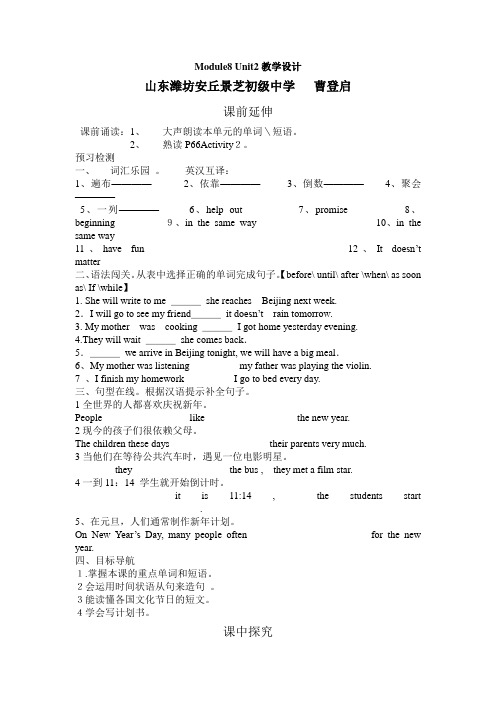
Module8 Unit2教学设计山东潍坊安丘景芝初级中学曹登启课前延伸课前诵读:1、大声朗读本单元的单词\短语。
2、熟读P66Activity2。
预习检测一、词汇乐园。
英汉互译:1、遍布————2、依靠————3、倒数————4、聚会————5、一列————6、help out__________7、promise_________8、beginning________ 9、in the same way ________ 10、in the same way _________11、have fun ______________ _12、It doesn’t matter_________________二、语法闯关。
从表中选择正确的单词完成句子。
【before\ until\ after \when\ as soon as\ If \while】1. She will write to me ___she reaches Beijing next week.2.I will go to see my friend___it doesn’t rain tomorrow.3. My mother was cooking ___I got home yesterday evening.4.They will wait ___she comes back.5.___we arrive in Beijing tonight, we will have a big meal.6、My mother was listening _________ my father was playing the violin.7 、I finish my homework _________ I go to bed every day.三、句型在线。
根据汉语提示补全句子。
1全世界的人都喜欢庆祝新年。
People _________________like __________________the new year.2现今的孩子们很依赖父母。
新外研版八年级英语下册Module8Unit2教学案例
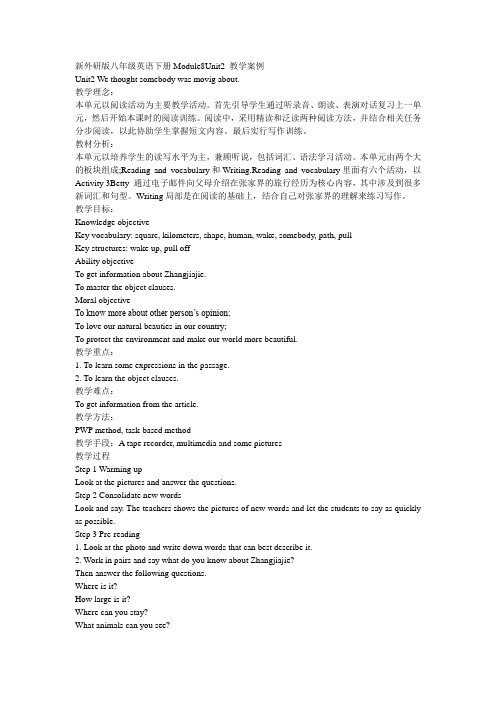
新外研版八年级英语下册Module8Unit2 教学案例Unit2 We thought somebody was movig about.教学理念:本单元以阅读活动为主要教学活动。
首先引导学生通过听录音、朗读、表演对话复习上一单元,然后开始本课时的阅读训练。
阅读中,采用精读和泛读两种阅读方法,并结合相关任务分步阅读,以此协助学生掌握短文内容。
最后实行写作训练。
教材分析:本单元以培养学生的读写水平为主,兼顾听说,包括词汇、语法学习活动。
本单元由两个大的板块组成;Reading and vocabulary和Writing.Reading and vocabulary里面有六个活动,以Activity 3Betty 通过电子邮件向父母介绍在张家界的旅行经历为核心内容,其中涉及到很多新词汇和句型。
Writing局部是在阅读的基础上,结合自己对张家界的理解来练习写作。
教学目标:Knowledge objectiveKey vocabulary: square, kilometers, shape, human, wake, somebody, path, pullKey structures: wake up, pull offAbility objectiveTo get information about Zhangjiajie.To master the object clauses.Moral objectiveTo know more about other person’s opinion;To love our natural beauties in our country;To protect the environment and make our world more beautiful.教学重点:1. To learn some expressions in the passage.2. To learn the object clauses.教学难点:To get information from the article.教学方法:PWP method, task-based method教学手段:A tape recorder, multimedia and some pictures教学过程Step 1 Warming upLook at the pictures and answer the questions.Step 2 Consolidate new wordsLook and say. The teachers shows the pictures of new words and let the students to say as quickly as possible.Step 3 Pre-reading1. Look at the photo and write down words that can best describe it.2. Work in pairs and say what do you know about Zhangjiajie?Then answer the following questions.Where is it?How large is it?Where can you stay?What animals can you see?What is the most famous thing to see?Step 4 ReadingRead the email and check your answers to Activity 2.Where is it?It’s in Hunan Province.How large is it?It’s about 480 square kilometres.Where can you stay?You can stay in camps or hotels.What animals can you see?You can see monkeys.What is the most famous thing to see?The tall, strangely shaped rocks are the most famous thing to see.Number the sentences in the correct order.Betty pulled a leaf off a plant.The noise woke everybody up.They climbed Mount Tianzi.A monkey made some noise.They camped by a small lake.Linging’s uncle said that people should protect everything in Zhangjiajie.Step 5 Learning to learnTo learn about the ways to read and write.Read and find out how Betty starts and finishes her email to her mum and dad. Next time when you write your email, you can start and finish the email in the same way.Step 6 Complete the sentences with the correct form of the words in the box.Read the sentences carefully.Choose the right words to fill in the blanks.human kilometre path shape wishAre there rocks in _______ or animal _______ in your home town?How many ___________ is Zhangjiajie from your home town?Is it safer to walk along a ______ or climb over rocks?Where do you ______ you were right now?Ask and answer the questions in Activity 5 in pairs.Step 7 Language points1. It’s very large, about 480 square kilometres.square kilometre, 表示“平方公里”。
外研版八年级下册英语Module8教学设计(Unit 1-Unit 3)
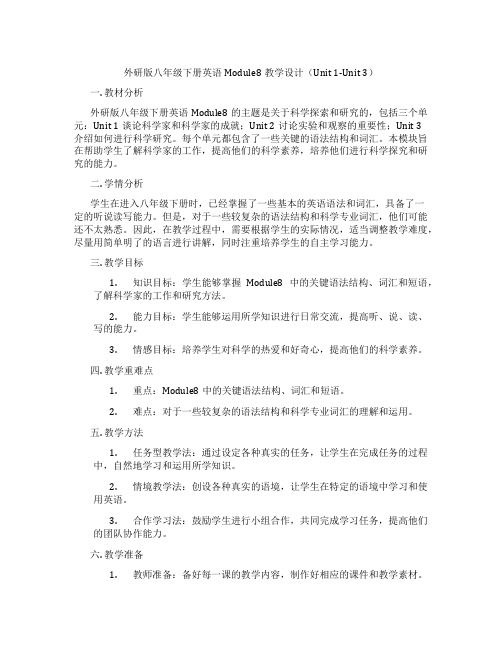
外研版八年级下册英语Module8教学设计(Unit 1-Unit 3)一. 教材分析外研版八年级下册英语Module8的主题是关于科学探索和研究的,包括三个单元:Unit 1谈论科学家和科学家的成就;Unit 2讨论实验和观察的重要性;Unit 3介绍如何进行科学研究。
每个单元都包含了一些关键的语法结构和词汇。
本模块旨在帮助学生了解科学家的工作,提高他们的科学素养,培养他们进行科学探究和研究的能力。
二. 学情分析学生在进入八年级下册时,已经掌握了一些基本的英语语法和词汇,具备了一定的听说读写能力。
但是,对于一些较复杂的语法结构和科学专业词汇,他们可能还不太熟悉。
因此,在教学过程中,需要根据学生的实际情况,适当调整教学难度,尽量用简单明了的语言进行讲解,同时注重培养学生的自主学习能力。
三. 教学目标1.知识目标:学生能够掌握Module8中的关键语法结构、词汇和短语,了解科学家的工作和研究方法。
2.能力目标:学生能够运用所学知识进行日常交流,提高听、说、读、写的能力。
3.情感目标:培养学生对科学的热爱和好奇心,提高他们的科学素养。
四. 教学重难点1.重点:Module8中的关键语法结构、词汇和短语。
2.难点:对于一些较复杂的语法结构和科学专业词汇的理解和运用。
五. 教学方法1.任务型教学法:通过设定各种真实的任务,让学生在完成任务的过程中,自然地学习和运用所学知识。
2.情境教学法:创设各种真实的语境,让学生在特定的语境中学习和使用英语。
3.合作学习法:鼓励学生进行小组合作,共同完成学习任务,提高他们的团队协作能力。
六. 教学准备1.教师准备:备好每一课的教学内容,制作好相应的课件和教学素材。
2.学生准备:学生需要提前预习Module8的内容,了解基本的语法结构和词汇。
七. 教学过程1.导入(5分钟)通过展示一些著名的科学家和他们的成就,激发学生的学习兴趣,引导学生思考科学家是如何进行研究的。
2.呈现(10分钟)教师通过课件展示Module8中的关键语法结构、词汇和短语,同时用简单的语言进行解释,确保学生能够理解。
Module8(教学设计)外研版(三起)英语六年级上册
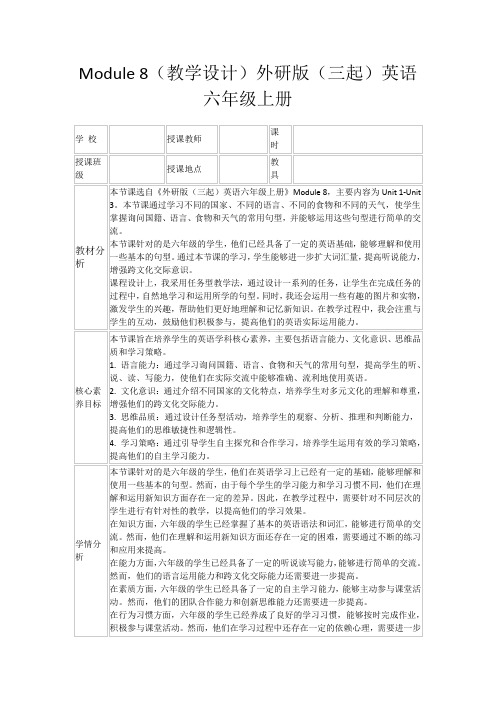
在能力方面,六年级的学生已经具备了一定的听说读写能力,能够进行简单的交流。然而,他们的语言运用能力和跨文化交际能力还需要进一步提高。
在素质方面,六年级的学生已经具备了一定的自主学习能力,能够主动参与课堂活动。然而,他们的团队合作能力和创新思维能力还需要进一步提高。
a. PPT:制作与课程内容相关的PPT,展示不同国家的国旗、语言、食物和天气等图片,帮助学生更好地理解和记忆。
b.视频:播放与课程内容相关的视频,如介绍不同国家文化的短片,让学生直观地了解不同国家的文化特点。
c.在线工具:利用在线工具,如Google地图,让学生搜索不同国家的地理位置,增强他们的空间观念。
-日本:The weather in Japan is seasonal. It has a hot summer and cold winter. There are four distinct seasons.
-巴西:The weather in Brazil is tropical. It has a hot and humid climate all year round.
教学过程设计
1.导入新课(5分钟)
目标:引起学生对不同国家文化的兴趣,激发其探索欲望。
过程:
开场提问:“你们喜欢旅游吗?如果有机会,你们想去哪个国家旅游呢?”
展示一些关于不同国家文化的图片或视频片段,让学生初步感受不同国家文化的魅力或特点。
简短介绍本节课的主题——不同国家文化的基本概念和重要性,为接下来的学习打下基础。
b.图书资源:推荐学生阅读一些介绍不同国家文化的书籍,如《世界文化地图》、《全球文化之旅》等,以丰富学生的知识储备。
外研社英语三年级下册《It's hot and sunny today》教案
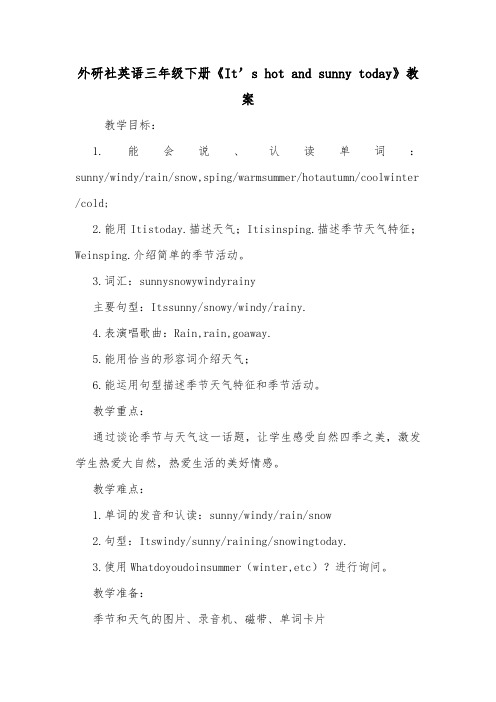
外研社英语三年级下册《It’s hot and sunny today》教案教学目标:1.能会说、认读单词:sunny/windy/rain/snow,sping/warmsummer/hotautumn/coolwinter /cold;2.能用Itistoday.描述天气;Itisinsping.描述季节天气特征;Weinsping.介绍简单的季节活动。
3.词汇:sunnysnowywindyrainy主要句型:Itssunny/snowy/windy/rainy.4.表演唱歌曲:Rain,rain,goaway.5.能用恰当的形容词介绍天气;6.能运用句型描述季节天气特征和季节活动。
教学重点:通过谈论季节与天气这一话题,让学生感受自然四季之美,激发学生热爱大自然,热爱生活的美好情感。
教学难点:1.单词的发音和认读:sunny/windy/rain/snow2.句型:Itswindy/sunny/raining/snowingtoday.3.使用Whatdoyoudoinsummer(winter,etc)?进行询问。
教学准备:季节和天气的图片、录音机、磁带、单词卡片教学过程:四季欣赏:复习sunny/windy/rain/snow,为下面的环节的进行做好知识与情感的铺垫;欣赏四季美景,激发对大自然的向往和热爱之情。
一、导入课题对当天的天气情况作一下描述,Itstoday,butits然后对课文中的四副图做一下观察。
二、小组合作,学习生词1.带领学生听一遍课文录音,Unit1活动一,整体感知课文,并画出生词,用磁带播放课文。
2.放第二遍录音,边听边读出黑板上的单词,可别难词反复跟读,掌握正确的发音。
3.小组合作学习黑板上的生词。
三、情景操练,学单词1.出示几张关于天气的图片,比如:raining,windy,snowing,sunny,认读并记忆这些词。
可以画出一些图示来表示这些词。
2.用以下几种方法进行操练小组内一人指表示天气的图片,其他人说出英语单词。
三年级英语下册 Module8 unit2(1)教案 外研版
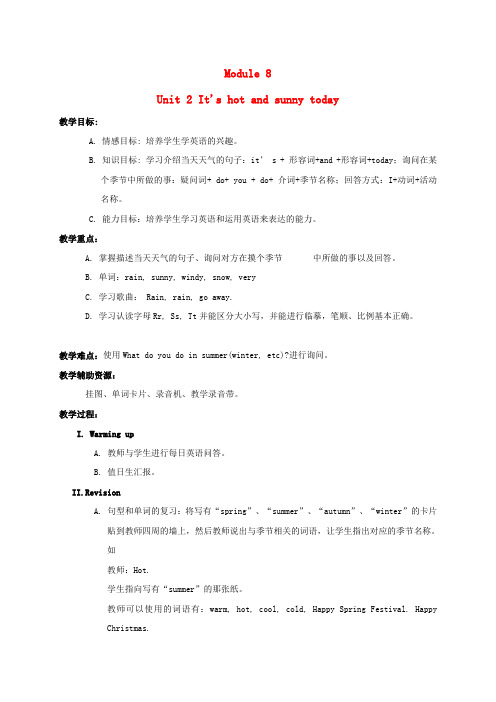
Module 8Unit 2 It's hot and sunny today教学目标:A. 情感目标: 培养学生学英语的兴趣。
B. 知识目标: 学习介绍当天天气的句子:it’ s + 形容词+and +形容词+today;询问在某个季节中所做的事:疑问词+ do+ you + do+ 介词+季节名称;回答方式:I+动词+活动名称。
C. 能力目标:培养学生学习英语和运用英语来表达的能力。
教学重点:A. 掌握描述当天天气的句子、询问对方在摸个季节中所做的事以及回答。
B. 单词:rain, sunny, windy, snow, veryC. 学习歌曲: Rain, rain, go away.D. 学习认读字母Rr, Ss, Tt并能区分大小写,并能进行临摹,笔顺、比例基本正确。
教学难点:使用What do you do in summer(winter, etc)?进行询问。
教学辅助资源:挂图、单词卡片、录音机、教学录音带。
教学过程:I. Warming upA. 教师与学生进行每日英语问答。
B. 值日生汇报。
II.RevisionA. 句型和单词的复习:将写有“spring”、“summer”、“autumn”、“winter”的卡片贴到教师四周的墙上,然后教师说出与季节相关的词语,让学生指出对应的季节名称。
如教师:Hot.学生指向写有“summer”的那张纸。
教师可以使用的词语有:warm, hot, cool, cold, Happy Spring Festival. HappyChristmas.B. 作业展示:将教师在上次课上布置的作业展示给大家:选出自己最喜欢的季节,将该季节名称写在一张大纸中间,在单词的周围画上或贴上与季节相关的图画。
让学生向全体同学展示他的作业,并说明最喜欢该季节的原因。
C. 字母的复习:给学生们看写有字母Aa----Qq的卡片,检查他们是否还记得这部分内容。
外研版九年级英语上册教案 Module8 Unit2

1)Scientists sometimes ________ our brains _________ computers.
2) My grandma likes to ____________life in the past _____ life now.
3) ________________________ his room, my room is even smaller.
教学准备
学具准备:课本、笔记本、笔
教具准备:电脑、PPT、黑板、粉笔
教学实施
教学环节与对应目标
教学内容
学习活动
评价活动
问题预设与补救措施
活动一:融入情境,以旧促新
90%的学生能掌握本课目标词汇的音形义
10%的学生能正确朗读目标词汇
1.课前读词,小组互查,个人抽查读词
2. Have a dictation检测单词的掌握情况
抽查两个小组,展示答案
1.问题预设:文章的篇章较长,学生很难找到关键点完成段落大意匹配的任务。
2.补救措辞:引导学生关注关键词和关键句,注意表达时间顺序的词如before, after等,以及内容关键词life, technology, future等。
活动三:Intensive Reading
1.通过完成任务,85%的学生能恰当运用扫读、寻读策略找出长、宽、深信息,其他在同伴互助和教师点拨下理解。
Para. 4 Technology and books
What are the advantages of the Internet?
1.________________________ 2. ________________________
3. ________________________ 4. ________________________
Module8(教学设计)外研版(一起)英语四年级上册

(1)语言能力
1.功能:全体学生能运用“When did they…?”使用特殊疑问句询问过去的行为。
2.语法:学习一般过去时的特殊疑问句及答语。全体学生能运用目标语句Whendid they come? They came last Wednesday. What did she play? She played the flute.
3.词汇:全体学生能正确理解并运用单词when, come-came,competition, win-won, gold cup, flute, practise,took, a lot。
4.语音:感知came中“a”的发音。感知stay, late, play及at, practise中“a”的发音, look和took中“oo”的发音。
5.Guessing competition T: Children, let’s listen, what did she/he play? Can you play any instruments? You do the actions, we will guess what you played.
What did you do last weekend? When did you do?
【设计意图】小组内积极合作,操练句型,在调查中完成本课任务。
小结与布置作业
Summary :学生自主总结本课所学
Homework: A.1. Make up two sentences with each new words; 2. Read the text for three times
(2)语法:学习一般过去时的特殊疑问句及答语。全体学生能运用目标语句When did they come? They came last Wednesday. What did she play? She played the flute.
Module8Unit2It
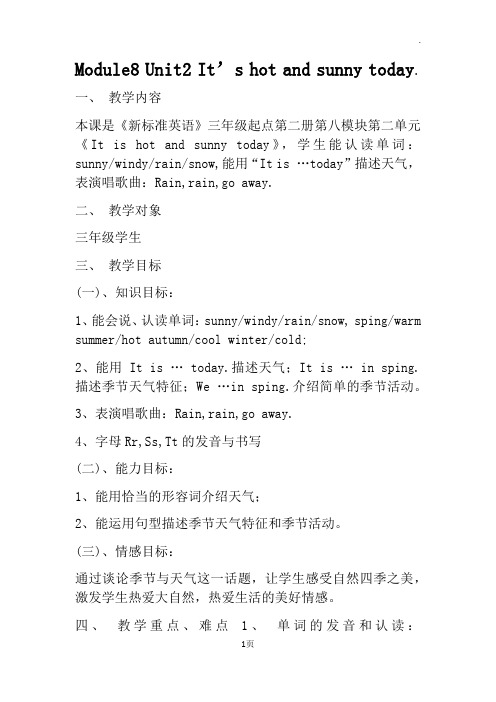
Module8 Unit2 It’s hot and sunny today.一、教学内容本课是《新标准英语》三年级起点第二册第八模块第二单元《It is hot and sunny today》,学生能认读单词:sunny/windy/rain/snow,能用“It is …today”描述天气,表演唱歌曲:Rain,rain,go away.二、教学对象三年级学生三、教学目标(一)、知识目标:1、能会说、认读单词:sunny/windy/rain/snow, sping/warm summer/hot autumn/cool winter/cold;2、能用It is … today.描述天气;It is … in sping.描述季节天气特征;We …in sping.介绍简单的季节活动。
3、表演唱歌曲:Rain,rain,go away.4、字母Rr,Ss,Tt的发音与书写(二)、能力目标:1、能用恰当的形容词介绍天气;2、能运用句型描述季节天气特征和季节活动。
(三)、情感目标:通过谈论季节与天气这一话题,让学生感受自然四季之美,激发学生热爱大自然,热爱生活的美好情感。
四、教学重点、难点1、单词的发音和认读:sunny/windy/rain/snow, 2、句型:It is windy/sunny/raining/snowing today. 3、 What do you do in sping /summer/autumn/winter?的拓展运用。
五、教学准备季节和天气的图片、自制课件、奖励贴画。
六、教学过程(一) 热身活动1、英文VCD四季欣赏:复习sunny/windy/rain/snow,为下面的环节的进行做好知识与情感的铺垫;欣赏四季美景,激发对大自然的向往和热爱之情。
2、 Guessing Game:检测巩固学生对sunny/windy/rain/snow 的发音与反映情况。
三年级英语下册 module8 unit2教案 外研版
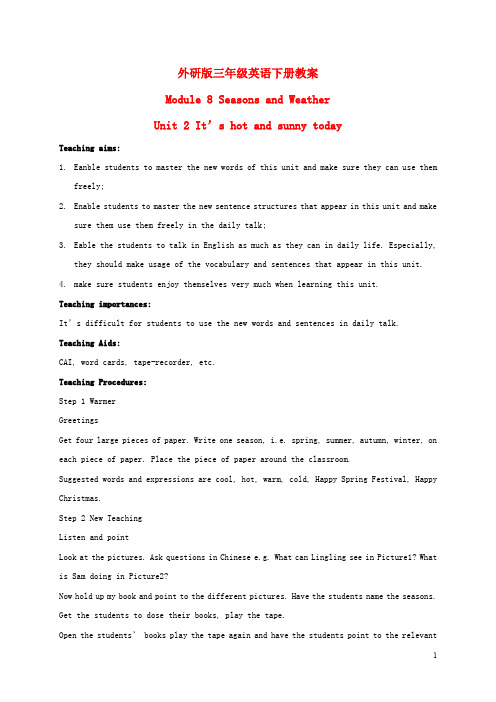
外研版三年级英语下册教案Module 8 Seasons and WeatherUnit 2 It’s hot and sunny todayTeaching aims:1.Eanble students to master the new words of this unit and make sure they can use themfreely;2.Enable students to master the new sentence structures that appear in this unit and makesure them use them freely in the daily talk;3.Eable the students to talk in English as much as they can in daily life. Especially,they should make usage of the vocabulary and sentences that appear in this unit. 4.make sure students enjoy themselves very much when learning this unit.Teaching importances:It’s difficult for students to use the new words and sentences in daily talk. Teaching Aids:CAI, word cards, tape-recorder, etc.Teaching Procedures:Step 1 WarmerGreetingsGet four large pieces of paper. Write one season, i.e. spring, summer, autumn, winter, on each piece of paper. Place the piece of paper around the classroom.Suggested words and expressions are cool, hot, warm, cold, Happy Spring Festival, Happy Christmas.Step 2 New TeachingListen and pointLook at the pictures. Ask questions in Chinese e.g. What can Lingling see in Picture1? What is Sam doing in Picture2?Now hold up my book and point to the different pictures. Have the students name the seasons. Get the students to dose their books, play the tape.Open the students’ books play the tape again and have the students point to the relevantpictures.Teach the new vocabulary, Mime looking up at the sky and then hurriedly putting up an umbrella. Say “It’s raining.” Get the stude nts to repeat the sentence. Follow the same procedure for ‘windy’, snowing and ‘sunny’.Teach the nouns ‘rain ’and ‘snow’.Point and sayS1: Cpoints to a picture 1) I t’s warm today but it’s raining.S2: It’s spring.Do some examples with the class.Act it outHave the students read the example dialogue.Now draw two columns on the board, label the columns ‘summer’ and ‘winter’ respectively. Divide the class into groups of three or four and have them continue the activity.Step 3 ConsolidationListen and say, then singListen, repeat and trace the letters.Step 4 The endUse the Activity BookGame: Colour game板书设计:Unit 2 It’s hot and sunny today.raining windy snowing sunny。
- 1、下载文档前请自行甄别文档内容的完整性,平台不提供额外的编辑、内容补充、找答案等附加服务。
- 2、"仅部分预览"的文档,不可在线预览部分如存在完整性等问题,可反馈申请退款(可完整预览的文档不适用该条件!)。
- 3、如文档侵犯您的权益,请联系客服反馈,我们会尽快为您处理(人工客服工作时间:9:00-18:30)。
Module8 Unit2 It’s hot and sunny today.
一、教学内容
本课是《新标准英语》三年级起点第二册第八模块第二单元《It is hot and sunny today》,学生能认读单词:sunny/windy/rain/snow,能用“It
is …today”描述天气,表演唱歌曲:Rain,rain,go away.
二、教学对象
三年级学生
三、教学目标
(一)、知识目标:
1、能会说、认读单词:sunny/windy/rain/snow, sping/warm summer/hot autumn/cool winter/cold;
2、能用It is … today.描述天气;It is … in sping.描述季节天气特征;We …in sping.介绍简单的季节活动。
3、表演唱歌曲:Rain,rain,go away.
4、字母Rr,Ss,Tt的发音与书写
(二)、能力目标:
1、能用恰当的形容词介绍天气;
2、能运用句型描述季节天气特征和季节活动。
(三)、情感目标:
通过谈论季节与天气这一话题,让学生感受自然四季之美,激发学生热爱大自然,热爱生活的美好情感。
四、教学重点、难点1、单词的发音和认读:sunny/windy/rain/snow, 2、句型:It is windy/sunny/raining/snowing today. 3、What do you do in sping
/summer/autumn/winter?的拓展运用。
五、教学准备
季节和天气的图片、自制课件、奖励贴画。
六、教学过程
(一) 热身活动
1、英文VCD四季欣赏:复习sunny/windy/rain/snow,为下面的环节的进行做好知识与情感的铺垫;欣赏四季美景,激发对大自然的向往和热爱之情。
2、 Guessing Game:检测巩固学生对sunny/windy/rain/snow的发音与反映情况。
3、 Do you know : 知识走入生活,了解四季中的节日,拓展游戏。
运用句型:It is in sunny/windy/rain/snow.
认知层次设计:熟悉复习四季名称——练习检测发音——运用拓展
(二) 新授过程
Step1:Color Game:(Unit2Part5)
活动设计:Colorful Seasons:五彩缤纷的季节。
课件展示:四季五彩缤纷的色彩,引导学生描述颜色,让其他同学猜一猜所描述的季节。
活动目的:1、承接课前活动,灵活处理了课文中Part5的练习活动;
2、激励学生描述季节颜色和特征,为下面课文学习做好承上启下的知识、情感铺垫。
Step2:重难点导入与导学(Unit2 Part1)
以旧知引新知。
由Unit1的季节天气复习与检测设置进入本课单词“sunny/windy/rain/snow”,句型“It is ...and ...today.”的情景,引导学生学习和认知新单词和句型。
呈现、完成课文Part1. Step3:重难点操练:1、Listening practice: Listening the sentences and find the new words.
2、Writing practice: write the letters:Rr,Ss,Tt.Write the words; raining,sunny,snowing,windy.
3、Reading practice: Learn,say,and act out the sentences.
4、Game:火眼金睛Find the right words.(巩固练习)
(三)、能力训练 Step1:Seasons and Weather.
Describe seasons,weather and sports.(综合拓展练习)
鼓励学生用学过的恰当句型来描述有关季节、天气、活动。
如;I
like ...sping/summer/autumn/winter
It is warm/hot/cool/cold/sunny/windy
in spring/summer/autumn/winter.
It is raining/snowing/warm/hot/cool/sunny/windy/today.
I...in spring/summer/autumn/winter.
Spring/summer/autumn/winter is red/green/yellow/white...ect.
Step2:(Unit2 Part3)运用句型:A:What do you do in spring/summer/autumn/winter?
B:I...in spring/summer/autumn/winter.
Step3:德育渗透,情感升华。
认知层次设计:各个句型的分学分练—综合运用—提升情感认知。
(四)、愉悦结尾
学唱歌曲;Rain,rain,go away.(Unit2 Part3)
学习在“Rain,rain,go away”的表演唱中结束,遵循“Starting in the high ,ending in the high”的教学理念。
(五)、布置作业
1、Find more weather ,colors,sports in four seasons.
2、Making a little dialogue about seasons and weather in pairs or groups.Let us show your
dialogue in next class.。
